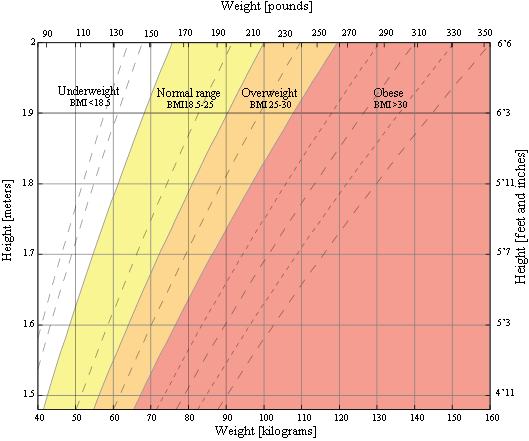The Body Mass Index (BMI) Calculator can be used to calculate BMI value and corresponding weight status while taking age into consideration. Use the "Metric Units" tab for the International System of Units or the "Other Units" tab to convert units into either US or metric units. Note that the calculator also computes the Ponderal Index in addition to BMI, both of which are discussed below in detail.
BMI introduction
BMI is a measurement of a person's leanness or corpulence based on their height and weight, and is intended to quantify tissue mass. It is widely used as a general indicator of whether a person has a healthy body weight for their height. Specifically, the value obtained from the calculation of BMI is used to categorize whether a person is underweight, normal weight, overweight, or obese depending on what range the value falls between. These ranges of BMI vary based on factors such as region and age, and are sometimes further divided into subcategories such as severely underweight or very severely obese. Being overweight or underweight can have significant health effects, so while BMI is an imperfect measure of healthy body weight, it is a useful indicator of whether any additional testing or action is required. Refer to the table below to see the different categories based on BMI that are used by the calculator.
BMI table for adults
This is the World Health Organization's (WHO) recommended body weight based on BMI values for adults. It is used for both men and women, age 20 or older.
| Classification | BMI range - kg/m2 |
| Severe Thinness | < 16 |
| Moderate Thinness | 16 - 17 |
| Mild Thinness | 17 - 18.5 |
| Normal | 18.5 - 25 |
| Overweight | 25 - 30 |
| Obese Class I | 30 - 35 |
| Obese Class II | 35 - 40 |
| Obese Class III | > 40 |
BMI chart for adults
This is a graph of BMI categories based on the World Health Organization data. The dashed lines represent subdivisions within a major categorization.

BMI table for children and teens, age 2-20
The Centers for Disease Control and Prevention (CDC) recommends BMI categorization for children and teens between age 2 and 20.
| Category | Percentile Range |
| Underweight | <5% |
| Healthy weight | 5% - 85% |
| At risk of overweight | 85% - 95% |
| Overweight | >95% |
Risks associated with being overweight
Being overweight increases the risk of a number of serious diseases and health conditions. Below is a list of said risks, according to the Centers for Disease Control and Prevention (CDC):
- High blood pressure
- Higher levels of LDL cholesterol, which is widely considered "bad cholesterol," lower levels of HDL cholesterol, considered to be good cholesterol in moderation, and high levels of triglycerides
- Type II diabetes
- Coronary heart disease
- Stroke
- Gallbladder disease
- Osteoarthritis, a type of joint disease caused by breakdown of joint cartilage
- Sleep apnea and breathing problems
- Certain cancers (endometrial, breast, colon, kidney, gallbladder, liver)
- Low quality of life
- Mental illnesses such as clinical depression, anxiety, and others
- Body pains and difficulty with certain physical functions
- Generally, an increased risk of mortality compared to those with a healthy BMI
As can be seen from the list above, there are numerous negative, in some cases fatal, outcomes that may result from being overweight. Generally, a person should try to maintain a BMI below 25 kg/m2, but ideally should consult their doctor to determine whether or not they need to make any changes to their lifestyle in order to be healthier.